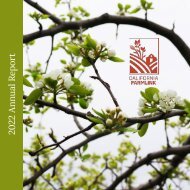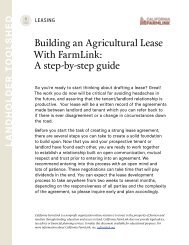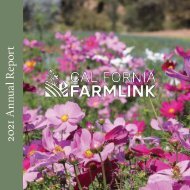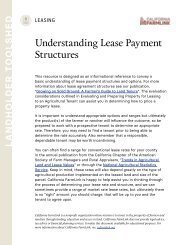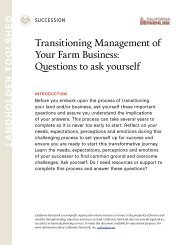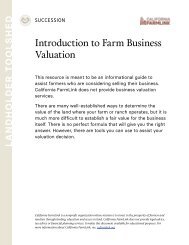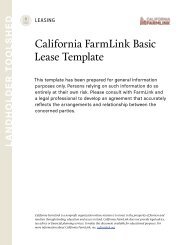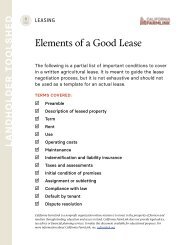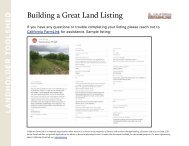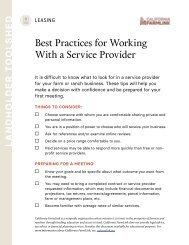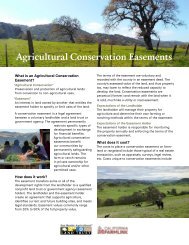Guide to Regenerative Grazing Leases: Opportunities for Resilience
California FarmLink and TomKat Ranch Educational Foundation teamed up to create this resource focused on land leases that support regenerative grazing practices. This guidebook aims to empower private, nonprofit, and public landholders, as well as easement-holders and grazing tenants.
California FarmLink and TomKat Ranch Educational Foundation teamed up to create this resource focused on land leases that support regenerative grazing practices. This guidebook aims to empower private, nonprofit, and public landholders, as well as easement-holders and grazing tenants.
Create successful ePaper yourself
Turn your PDF publications into a flip-book with our unique Google optimized e-Paper software.
CHAPTER 2. <strong>Grazing</strong> <strong>Leases</strong> (Continued)<br />
TERMINATION/BINDING ON HEIRS<br />
Sufficient opportunity <strong>for</strong> notification of default, cure of default, and notice of<br />
termination is recommended <strong>for</strong> agricultural leases. Termination terms must outline<br />
appropriate time allowances <strong>for</strong> moving animals off property following a notice of<br />
termination. A clause specifying that the agreement is binding on heirs secures<br />
tenure in the event of ownership transfer.<br />
?<br />
IMPORTANT NOTE: The lease term is only as secure as the process <strong>for</strong><br />
termination and cure of default: A ten-year lease with a termination that allows <strong>for</strong> 14<br />
days’ notice of termination clause without cause is effectively a 14-day lease.<br />
IN SUMMARY<br />
A well-written lease is clear, concise and easy <strong>to</strong> follow. It legally binds both parties<br />
(landholder and lessee) <strong>to</strong> uphold the lease intent and their responsibilities <strong>to</strong> each<br />
other, and protects each party from avoidable harm. It sets clear boundaries <strong>for</strong><br />
allowable and prohibited uses and practices, and explores some of the imaginable<br />
‘what-if’s.’<br />
<strong>Leases</strong> should be rigorous and clear enough <strong>to</strong> attract innovative and effective<br />
graziers who are aligned with the landholder’s goals, yet not so onerous as <strong>to</strong> prevent<br />
them from adapting <strong>to</strong> changes beyond their control, or as <strong>to</strong> dissuade them from<br />
accepting the lease’s terms.<br />
For a grazing lease <strong>to</strong> promote regenerative land stewardship, it must strike a<br />
balance between rigor and adaptability. Its intent must align with the core principles<br />
of regenerative agriculture. It should set clear, actionable goals, ideally with the living<br />
guidance of an adaptive, agricultural management plan (AMP). A good moni<strong>to</strong>ring<br />
and evaluation process are essential <strong>to</strong> keep the lease parties pointed at their guiding<br />
star.<br />
Finally, a good regenerative grazing lease is underpinned by a healthy relationship<br />
and thoughtful communication process between the landholder and lessee.<br />
Landholders wishing <strong>to</strong> leave a legacy of healthy working lands and viable agricultural<br />
businesses should plan early <strong>for</strong> a viable transition <strong>to</strong> the next generation.<br />
When designed with careful <strong>for</strong>esight, firm expectations, and room <strong>for</strong> adaptive<br />
change by all stakeholders, a regenerative grazing lease can promote optimal<br />
agricultural productivity, ecological resilience, and community well-being.<br />
© Copyright 2022 Cali<strong>for</strong>nia FarmLink and TomKat Ranch Educational Foundation<br />
30



